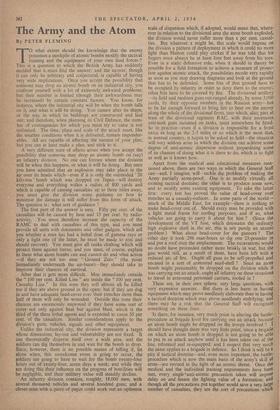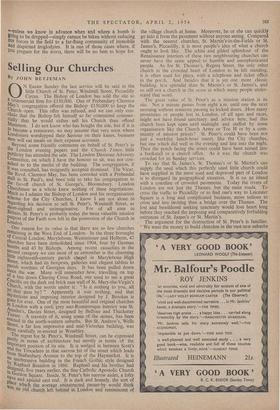The Army and the Atom
By PETER FLEMING TO what extent should the knowledge that the enemy possesses a stockpile of atomic bombs modify the tactical training and the equipment of your own land forces ? This is a question to which the British Army has suddenly decided that it ,must find the answer; and the answer, though it can only be arbitrary and conjectural, is capable of having very wide implications. Once you accept the possibility that someone may drop an atomic bomb on an industrial city, you confront yourself. with a lot of extremely awkward problems; but their number is limited (though their awkwardness may be increased) by certain constant factors. You know, for instance, where the industrial city will be when the bomb falls on it, and what it will be doing. You cannot alter its shape, or the way in which its buildings are constructed and laid out; and therefore, when planning its Civil Defence, the num- ber of contingencies for which you must try to cater is not unlimited. The time, place and scale of the attack must, like the weather conditions when it is delivered, remain imponder- ables. All are capable of affecting the success of your plan, but you can at least make a plan, and stick to it. A very different state of, affairs arises when you accept the possibility that someone may drop an atomic bomb on (say) an infantry division. No one can foresee where the division will be when this happens, or what it will be doing. But once you have admitted that an explosion may take place in the air over its heads which—even if it is only the outmoded ' 20 kilo-ton' bomb which was dropped on Japan—will destroy everyone and everything within a radius of 800 yards and which is capable of causing casualties up to three miles away, you must give the division some guidance on how to minimise the damage it will suffer from this form of attack. The question is: what sort of guidance ?
The first part of the answer is easy. Fifty per cent. of the casualties will be caused by heat and 15 per cent. by radio- activity. You must therefore increase the capacity of the RAMC to deal with casualties of this type, and you must provide all units with dosimeters and other gadgets, which tell you whether a man has had a lethal dose of gamma rays or only a light one (if the latter, he must be made to rest and should recover). You must give all ranks clothing which will protect them against burns; and you must, of course, explain to them what atom bombs can and cannot do and what action —if they are not too near " Ground Zero " (the point immediately underneath the air-burst)—they should take to improve their chances of survival. scale of dispersion which, if adopted, would mean that, where- ever in relation to the divisional area the atom bomb exploded, the division would never suffer more than x per cent. casual- ties. But whatever x might be, this scale would impose on the division a pattern of deployment in which it could no more fight than Hutton could play cricket if he was told that his fingers must always be at least four feet away from his toes. Even in a static defensive role, when it should in theory be possible for a field formation to achieve a measure of protec- tion against atomic attack, the possibilities recede very rapidly as soon as you stop drawing diagrams and look at the ground that has to be defended. Some bits of that ground have to be occupied by infantry in order to deny them to the enemy; other, bits have to be covered by fire. The divisional artillery —its field and medium guns out-ranged already, by some 3,000 yards, by their opposite numbers in the Russian army—has to be far enough forward to bring fire to bear on the enemy along the whole of the divisional front, into which; also, part at least of the divisional regiment RAC, with their enormous anti-tank guns mounted on tanks, must somewhere be fitted'. So in practice—even if a division is responsible for a front twice as long as the 2-3 miles, or so which is the most that, I in normal country, it hopes to 'be asked to hold—the situation will very seldom arise in which the division can achieve some degree of anti-atomic dispersion without jeopardising some of its chances of doing what it is there to do, which is to fight as well as it knows how.
Apart from the medical and educational measures men- tioned above. there are two ways in which the General Staff can—and, I imagine, will—tackle the problem of making the Army partially atom-proof. One is to modify virtually all, existing tactical doctrine; the other is to produce some new, and to modify some existing equipment. To take the latter first: every test has proved the value of head-cover over trenches as a casualty-reducer. In some parts of the world— much of the Middle East, for example—there is nothing to make head-cover out of. Should every man be provided with a light metal frame for roofing purposes, and if so, what vehicles are going to carry it about for him ? (Since the development of the VT fuse, which detonates the ordinary high explosive shell in the air, this is not purely an atomic problem.) What about head-cover for the gunners ? The other day it took 298 man-hours to dig one 25-pounder in and put a roof over the emplacement. The excavations would no doubt have proceeded rather more briskly in war, but the gun would still, as a result of them, have been left with a reduced arc of fire. Ought all guns to be self-propelled and encased in a sort of armoured snail-shell ? Since an aut', bomb might presumably be dropped on the division while it was carrying out an attack, ought all infantry on these occasions to travel in armoured personnel carriers, roofed in ?
These are, in their own sphere, very large questions, with very expensive answers. But there is less harm in having equipment which may prove needlessly elaborate than in having a tactical doctrine -which may prove needlessly stultifying; and there may be a risk that the General Staff will excogitate something on these lines. Is there, for instance, very much point in altering the battle- procedure at brigade level for carrying out an attack because an atom bomb might be dropped on the troops involved ? should have thought there was very little point, since a brigade on which an atom bomb is dropped is not going to be able to put in an attack anyhow until it has been taken out of the line, reformed and re-equipped; and I suspect that very much the same applies to a brigade in defence. So 1 think it will be a pity if tactical doctrine—and, even more important, the battle- procedure which is now the main basis of the army's skill at arms—are revised in the light of an atomic threat. Once the medical and the individual training requirements have .been met, every single wand-atomic precaution taken will impose delay on and lessen the fighting value of a formation; and though all the precautions put together would save a very large number of casualties, they are the sort of precautions which `—unless we know in advance when and where a bomb is going to be dropped—simply cannot be taken without reducing Our forces in the field to a far-flung community of immobile and dispirited troglodytes. It is one of those cases where, if You prepare for the worst, there will be no best to hope for.



















































 Previous page
Previous page